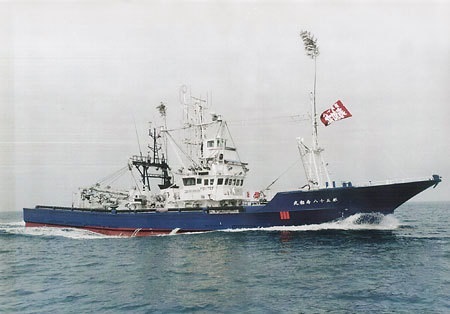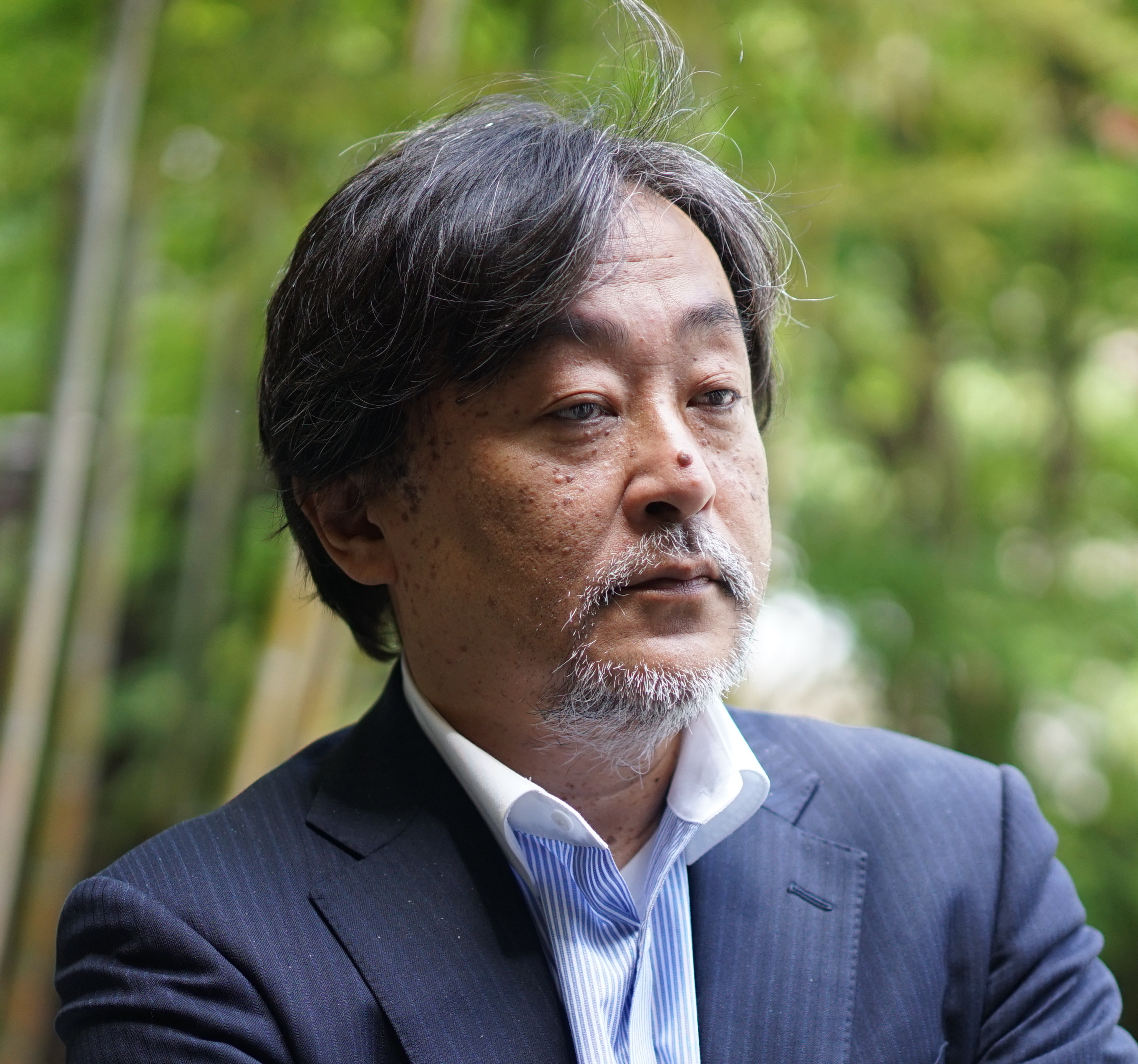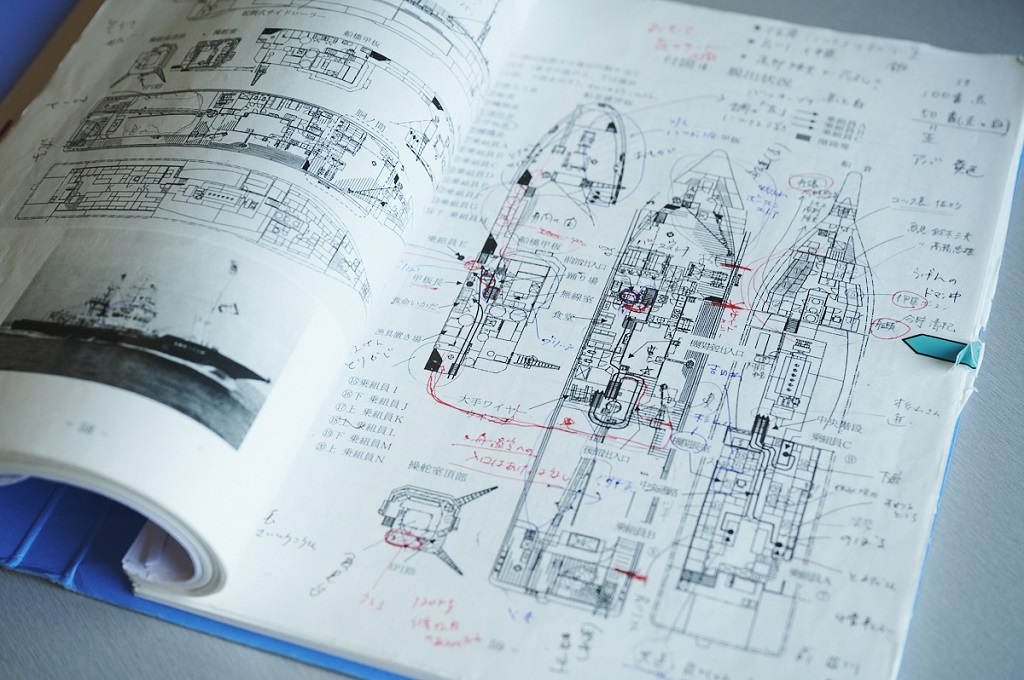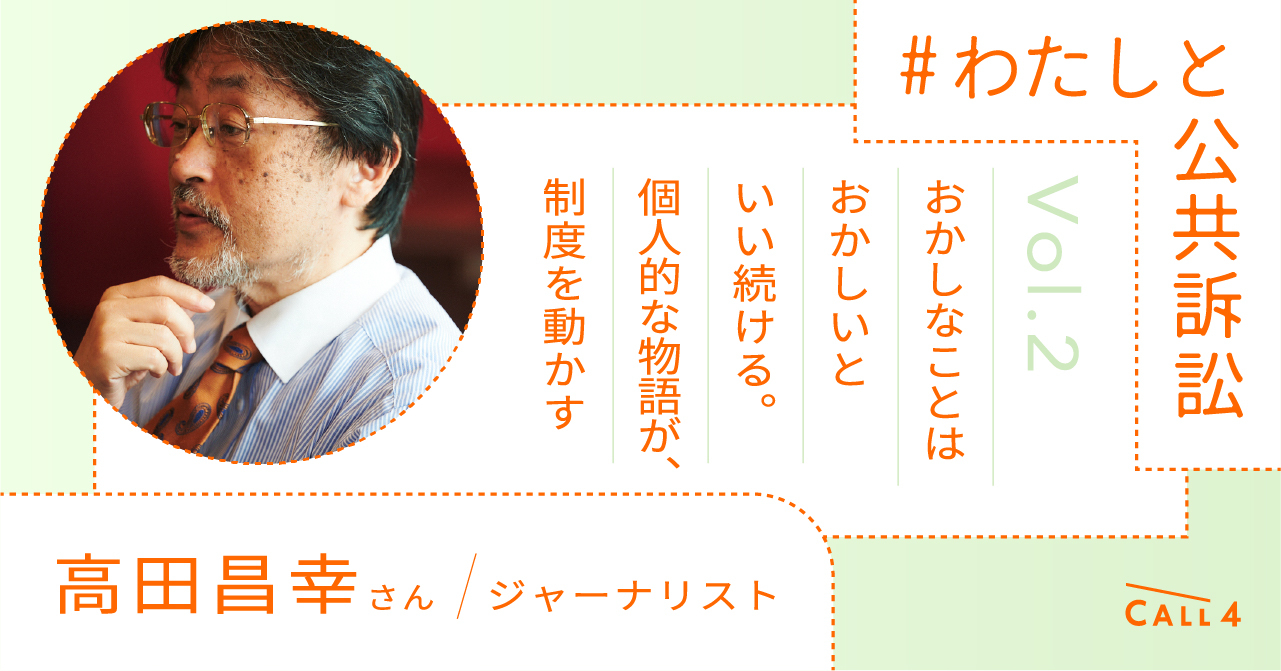隠される「国の事故調査」プロセスを明らかに!訴訟 Attempting to force the government to release the details of their investigation into the tragic death at sea of 17 people in 2008

2008年、太平洋上で福島県の漁船・第58寿和丸が沈没し、17人が犠牲になった。「波による転覆、沈没」とした国の運輸安全委員会の結論は、生存者の証言や現場海域の油の状況と大きく食い違う。一部専門家が潜水艦との衝突も疑う中、調査報道グループ・フロントラインプレスは国に情報開示請求したが、調査に使用した資料のタイトルすら非開示になった。なぜ、調査プロセスを隠すのか。公文書の開示を求めて提訴した。 In 2008, a Japanese fishing boat suddenly sank, killing 17 people. Some experts suspected a collision with a submarine, but the government concluded the cause was waves. What is the truth?
第4回口頭弁論期日
4th oral argument date
2022/3/30 12:45
2022年3月24日(木)午後1時30分、東京地裁703号法廷で、第4回口頭弁論期日がありました。2021年7月19日に提訴してから8カ月余。被告からようやく、不開示理由をある程度具体的に記載した準備書面が出て来ました。
これまでの過程を振り返ると、
2020年 1月27日 フロントラインプレスが情報公開請求
2020年 2月26日 運輸安全委員会事務局長 「開示」決定
実際はすでにインターネットに公表している文書を「公開」しただけで、情報公開請求した文書は何も公開しませんでした。
2020年 5月22日 フロントラインプレスが審査請求
2020年12月25日 情報公開・個人情報保護審査会(※)、処分妥当とする答申
※ 委員:藤谷俊之、泉本小夜子、磯部哲
2021年 1月22日 運輸安全委員会委員長、請求棄却の裁決
2021年 7月19日 フロントラインプレス、提訴
フロントラインプレスが情報公開請求してから、2年以上経過しています。
運輸安全委員会が不開示の範囲と理由を最初から真面目に検討していたら、回答にこんなに年月がかかるはずがありません。最初の不開示決定のときに詳しく書いてくれていていいはずです。それができないのは、最初の不開示決定のときに真面目に検討していなかったからです。
提訴後も日にちがかかっているのは、情報公開・個人情報保護審査会が運輸安全委員会にボーンインデックス(個々の不開示箇所とこれに対する不開示根拠・理由)の作成を求めることさえせず(もしかすると請求対象文書自体にもろくに目を通さず?)、「なにも開示しなくていい」というお墨付きを与えてしまったからです。
第4回口頭弁論期日の段階になっても、「運輸安全委員会が報告書作成のために収集・利用した調査資料(公表資料を除く)」はすべて非公開、これら調査資料の資料項目一覧(文書のタイトル)さえ墨塗りが多いままで、まだまだボーンインデックスの段階にさえ辿り着いていません。
審査会の杜撰な運用が行政機関の情報公開制度の消極的な運用を支えていると言える現状があります。
さらに、運輸安全委員会事務局長は、2022年3月17日付通知書で、不開示理由を変更しました。検討資料の内容の全部不開示については特段、新しい説明はなく、資料一覧表の文書には4類型の情報(①関係者からの聴取情報、②事故に関する事実情報、③試験研究解析情報、④委員会の審議情報)が含まれていて、これらは情報公開法5条5号及び6号柱書に該当すると書かれていました。
これで不開示事由(情報公開法5条5号、6豪柱書)に該当する合理的な理由を説明したとは到底言えないと思います。
次回期日は、5月17日(火)午前11時45分。
原告側が主張する順番です。
1つは、訴えの変更です。今年1月6日に運輸安全委員会事務局長が不開示範囲を少なくする開示決定を改めて行ったことで、裁判の争点が提訴のときよりも少し少なくなりました。その関係で、原告側は訴えの変更をすることになりました。
もう1つは、被告の準備書面(2)(3)に対する反論です。さらに対象文書の墨塗り範囲を狭めることができるような主張ができれば、と考えています。
The 4th oral argument was held at the Tokyo District Court No. 703 at 1:30 pm on Thursday, March 24, 2022. It has been more than eight months since the suit was filed on July 19, 2021. The defendant finally came up with a brief stating the reason for non-disclosure to some extent.
Looking back on the process so far,
January 27, 2020 Frontline Press Requests Information Disclosure
February 26, 2020 Japan Transport Safety Board Secretary General "Disclosure" decision
In fact, we only "published" the documents that had already been published on the Internet, and did not publish any documents that requested information disclosure.
May 22, 2020 Frontline Press Requests Examination
December 25, 2020 Information Disclosure / Personal Information Protection Examination Committee (*), report that disposal is appropriate
* Members: Toshiyuki Fujitani, Sayoko Izumimoto, Tetsu Isobe
January 22, 2021 Japan Transport Safety Board Chairman, decision to dismiss claim
July 19, 2021 Frontline Press filed suit
It has been more than two years since Frontline Press requested information disclosure.
If the Japan Transport Safety Board had been seriously considering the scope and reasons for non-disclosure from the beginning, it would not take so long to answer. You should be able to write in detail at the time of the first non-disclosure decision. We can't do that because we didn't take it seriously at the time of our first non-disclosure decision.
It's been a long time since the complaint was filed, because the Japan Transport Safety Board did not even ask the Japan Transport Safety Board to create a bone index (individual non-disclosure points and grounds / reasons for non-disclosure). (Maybe you didn't read the billing document itself?), And gave the endorsement that "you don't have to disclose anything."
Even at the stage of the 4th oral argument date, all "survey materials (excluding published materials) collected and used by the Japan Transport Safety Board to prepare reports" are not disclosed, and a list of material items for these survey materials. Even (the title of the document) is still heavily inked and has not even reached the bone index stage.
It can be said that the unscrupulous operation of the examination committee supports the passive operation of the information disclosure system of government agencies.
In addition, the Secretary-General of the Japan Transport Safety Board changed the reason for non-disclosure in the notice dated March 17, 2022. There is no new explanation regarding the non-disclosure of all the contents of the study materials, and there are four types of information in the document list of materials ((1) hearing information from related parties, (2) factual information on accidents, (3) test research analysis information, and (4). The committee's deliberation information) was included, and it was stated that these corresponded to Article 5, Item 5 and Item 6 of the Information Disclosure Law.
I don't think it can be said that this explained the rational reason for non-disclosure (Article 5, Item 5, 6 Australian Pillars of the Information Disclosure Law).
The next date is 11:45 am on Tuesday, May 17th.
It is the order in which the plaintiffs insist.
One is the change of complaint. On January 6, this year, the Secretary-General of the Japan Transport Safety Board made a new disclosure decision to reduce the scope of non-disclosure, and the issues in the trial were slightly less than when the complaint was filed. In that connection, the plaintiffs have decided to change their complaints.
The other is a counterargument to the defendant's briefs (2) and (3). I would like to make a claim that can further narrow the scope of the target document.
第3回期日報告
3rd due date report
2022/2/1 22:04
2022年1月27日午前10時30分から、東京地裁703号法廷で、第3回口頭弁論期日がありました。前回の期日が昨年11月18日でしたから、実に2ヶ月と9日ぶりです。
この間にドラマがありました。と言うより、処分庁(運輸安全委員会)の非開示処分があまりにも雑だったため、処分庁は原処分を見直さざるを得なくなっていました。その見直し期間です。そして、今年1月6日付で、処分庁は、原処分を見直し、保有文書の表題の一部を開示する決定をしました。
これにより、全部不開示だった(決定書には「開示決定」と書いてありましたが、実態は公表情報を「開示」しただけなので、情報公開請求した意味のない全部不開示決定です)「(2008年6月23日に発生した漁船第五十八寿和丸沈没事故に関して運輸安全委員会が報告書作成のために収集・利用した調査資料の)資料項目一覧」の一部が開示されることになりました。
が、「運輸安全委員会が報告書作成のために収集・利用した調査資料の一切」を開示請求している部分については、やり直しの処分でも、インターネットで公表されている文書以外は全く開示されませんでした。
開示されたのは表題だけですから、内容は一切わかりません。表題冴墨塗りのままのものがまだたくさんありました。全部海苔弁がところどころに穴が開いた程度です。
まあ、これはこれで幾らかの前進ということで評価してもいい。だが、じゃあ、依然墨塗りとなっている箇所それぞれの不開示理由はなんなの?という理由付記の課題が残っているのだが、処分庁は、何と、原処分の不開示理由とほとんど同文の抽象的理由を書いて来たのです。えっ!!! 理由の付記になっていないんですけど。
第3回期日では、原告代理人の清水弁護士から、やり直し処分の不開示部分について、不開示理由の説明が抽象的すぎて、どのような文書のどの部分が、どのような理由で情報公開法が定める不開示事由に該当するか全くわからないから、それぞれの墨塗り部分の不開示理由をそれぞれ明らかにする書き直してもらいたい、そうしないと、原告としてはどこの不開示は納得でき、どこの不開示が納得できないか判断ができない、と指摘しました。
裁判所は、この原告の指摘をもっともだと認めて、被告の指定代理人に対して、この点を処分庁に検討し直してもらうよう求めました。
被告指定代理人にはその意味がすぐわからなかったのか、これ以上処分のやり直しをすることはないし、不開示理由について今後、書面でまた主張するから、原告が反論するならその後にしてもらえればよいと述べました。
裁判長は、それもそうか、と一旦納得しかけ、原告代理人の方を向いて、被告は現状を変える気はないということなので、原告側から現段階での反論の準備書面を出してもらえないかと言いました。被告が処分内容をこれ以上変えない、不開示理由もこのままなら、原告としてはこれを前提に反論の準備書面を書くしかないかと思いました。
がしかし、いやいや、ちょっと考えてみたら、無理無理無理。このままでは反論を書けないと直感しました。なぜなら、文書の表題さえわからない、内容は一切わからない、しかも、1つ1つの墨塗り箇所を不開示とした理由が一切示されていないのですから、原告としては1つ1つが情報公開法の不開示事由に該当するかしないか検討のしようがありません。あれこれ想像して書いたところで、対象文書をみている被告側は、相変わらず抽象論を繰り返すだけでは、裁判所にとってもどういう情報のついて争いになっているのかわかりません。空虚な主張のやりとりになり、裁判手続は無駄になります。
裁判長もわかってくれたらしく、原告の指摘は理解できるとして、被告指定代理人に対し、まず処分庁のほうで、今回の原告の指摘を受けて、やり直しの処分通知書に記載した不開示理由の説明内容を見直してもらいたい、ボーンインデックスのような書き方でもいいと、改めて要請し、どれくらいでできそうですかと問いました。
被告席の指定代理人3人は、まさか裁判長がこんなことを言い出すとは予想していなかったと言わんばかりに固まっていました。主任と思われる指定代理人が他の2人の指定代理人に声を掛けて、たぶん、裁判長の要請には応じるしかないとした上で、どれくらいの期間があれば準備できるだろうか、という話をしていたのだと思います。裁判長の注文が予想しているものなら、事前に準備期間を考えているので、数秒で代理人同士の合意はできます。しかし、今回のひそひそ話はやたら長い。30秒か40秒かそれ以上か。とにかく長い時間がかかっていました。結果、3月15日までに不開示理由の説明内容を見直したものを提出することになりました。
次回期日は、3月24日午後1時30分、703号法廷です。
運輸安全委員会の運用を開かれたものにするにはまだまだ苦難の途が続きそうです。
From 10:30 am on January 27, 2022, there was a third oral argument date at the Tokyo District Court No. 703 court. The last date was November 18th last year, so it's been 2 months and 9 days since then.
There was a drama during this time. Rather, the non-disclosure disposition of the Disposal Agency (Japan Transport Safety Board) was so crude that the Disposal Agency had to review the original disposition. It is the review period. Then, on January 6, this year, the Disposal Agency decided to review the original disposal and disclose a part of the title of the possessed document.
As a result, all information was not disclosed (although the decision stated that it was "disclosure decision", the fact is that the information was only "disclosed", so it is meaningless to request information disclosure.) " Part of the "List of Material Items" (of the survey materials collected and used by the Japan Transport Safety Board to prepare the report regarding the sinking accident of the 58th Suwamaru fishing vessel that occurred on June 23, 2008) was disclosed. It was decided to do so.
However, regarding the part requesting disclosure of "all the investigation materials collected and used by the Japan Transport Safety Board to prepare the report", even if it is redoed, all documents other than those published on the Internet will be disclosed. did not.
Only the title was disclosed, so I don't know what it is. There were still a lot of things that were still painted with black ink. All the seaweed valves have holes in some places.
Well, this can be evaluated as some progress. But then, what is the reason for not disclosing each part that is still blackened? However, the Disposal Agency has written an abstract reason that is almost the same as the reason for non-disclosure of the original disposition. eh! !! !! I haven't added the reason.
On the third date, the plaintiff's attorney, Mr. Shimizu, explained the reason for non-disclosure about the non-disclosure part of the redoing disposition because it was too abstract. Since I do not know at all whether it corresponds to the reason for non-disclosure specified by, I would like you to rewrite it to clarify the reason for non-disclosure of each inked part, otherwise the plaintiff will be convinced of which non-disclosure and which non-disclosure He pointed out that he could not judge whether the disclosure was convincing.
The court justified the plaintiff's point and asked the defendant's designated agent to reconsider this point with the Disposal Agency.
Perhaps the defendant's designated agent did not immediately understand the meaning, he will not redo the disposition anymore, and he will argue again in writing about the reason for non-disclosure, so if the plaintiff argues, it should be done afterwards. Said.
The presiding judge once convinced that this was the case, and turned to the plaintiff's agent, saying that the defendant had no intention of changing the status quo, so the plaintiff should issue a brief to prepare for the counterargument at this stage. I asked if there was one. If the defendant does not change the content of the disposition any more and the reason for non-disclosure remains the same, I thought that the plaintiff would have no choice but to write a brief for the counterargument on the premise of this.
However, no, when I think about it for a moment, it's impossible. I had an intuition that I couldn't write a counterargument as it was. Because I don't even know the title of the document, I don't know the contents at all, and there is no reason for not disclosing each blackened part, so as a plaintiff, each one is not disclosed under the Information Disclosure Law. There is no way to consider whether or not it corresponds to the reason. As I imagined and wrote about it, the defendant looking at the target document does not know what kind of information the court is in dispute just by repeating the abstract theory as usual. It will be an empty allegation and the court procedure will be wasted.
It seems that the presiding judge also understands, and the plaintiff's point is understandable, so the disposition agency first received the plaintiff's point and stated the reason for non-disclosure in the disposition notice of redoing to the defendant's designated agent. I asked him to review the contents of the explanation, and asked him again that he could write it like a bone index, and asked how long it would take.
The three designated agents in the defendant's seat were so entrenched that they didn't expect the presiding judge to say this. The designated agent, who seems to be the chief, called out to the other two designated agents, saying that they probably had no choice but to respond to the request of the presiding judge, and how long would it take to prepare? I think I was talking. If the presiding judge's order is expected, the preparation period is considered in advance, so the agents can agree with each other in a few seconds. However, this secret story is rather long. 30 seconds, 40 seconds or more? It took a long time anyway. As a result, we have decided to submit a revised version of the explanation of the reason for non-disclosure by March 15.
The next date is Court No. 703 at 1:30 pm on March 24th.
It seems that it will continue to be difficult to make the operation of the Japan Transport Safety Board open.
第2回口頭弁論期日
2nd oral argument
2021/12/3 13:40
2021年11月18日午前10時30分から東京地方裁判所703号法廷で、第2回口頭弁論期日があった。
通常は、第1回口頭弁論で、遅くも第2回口頭弁論期日で、原告の訴状の主張に対して、被告側から認否と反論骨子の主張を書いた準備書面を出すことになっている。
この日、被告(国・運輸安全委員会事務局長)から提出された準備書面(1)は26ページもあった。さぞかし充実した中身になっているのかと思いきや・・・、予測は外れた。
訴状の認否は3ページ、その後を読み進むと、「事案の概要」「運輸安全委員会による船舶事故調査等について」「事実経過」。これら原告が訴状に書いている内容を繰り返しで7ページも費やしていた。もっと驚いたのはその先にあった。情報公開訴訟における司法審査・審理等の在り方について独自論を延々11ページにわたって繰り広げていた。で、肝心の本件不開示処分についての詳しい主張は次の準備書面でと予告して終わっていた。
国相手の情報公開訴訟をいくつかやっている出口弁護士によると、この独自論は、最近の国の書面ではほぼ常に出てくる定番の主張なのだそうだ(同じくCALL4のサイトに掲載されている「警察庁が保有する秘密個人情報ファイル簿の情報公開訴訟」で国が出した答弁書10頁以下の主張と、今回の被告準備書面(1)15頁以下の主張を見比べてみてほしい)。
ざっくりと要約すると、行政機関が不開示とした部分が本当に情報公開法が定める不開示事由に該当するかを裁判所で審理するに際して、国は、不開示部分の記載内容を離れて類型的・抽象的な主張をすればよく、裁判所はこれに基づき一般的類型的な判断をすることが想定されているのだ、と。言い換えれば、裁判所は行政実務の現場に口出しするなというもの。
被告が主張の拠り所に引用している判例は27年前(1994年)のもの、書証として提出した文献も20年前(2001年)のもの。最近の判例や文献を証拠に出さない。国はいつの時代の水準で裁判をしようとしているのか。不思議だ。
東京地裁では行政事件は専門部で扱っているので、裁判官は情報公開訴訟にも慣れている。同じ主張をこれまでにも幾度も見ているのだろう。裁判長は国の主張に関心を示さない。「反論の主張はいつ出すんですか」と被告側に問い質した。経過からすれば、国はすぐに反論できるはずなのだ。運輸安全委員会は、原告から昨年1月に情報公開請求を受けているからその直後に不開示理由を精査していたはずだ。不開示決定に対して原告が不服申立をしたことで、運輸安全委員会は情報公開・個人情報保護審査会に不開示理由を説明したはずだ。原告に訴訟を起こされたら、運輸安全委員会はそれまで判断していたことを繰り返せばいいだけのことなのだ。裁判長の問いは当然だ。準備に時間がかかるはずがない。
ところが、そこで3人の被告代理人は顔を突き合わせて、いつまでに書面を出すか議論を始めた。え、決めていなかったのか。と間もなく、指定代理人のひとりが「1月中に提出します」と答えた。裁判長は口にこそ出さなかったが、マスク越しでも驚きの表情が窺えた。被告の引き延ばし戦術に対して、かなり時間がかかるようですが、決定を見直すことも考えているのですか、と問い返した。部分的にでも開示してはどうかと言っているように聞こえた。
国の指定代理人は、当初の不開示処分の内容を改めて精査していると答えた。言葉だけからすると、裁判長の誘導に応じるように聞こえるが、最初の準備書面でこんなとんでも主張をした国のことだから、次の主張で新たに不開示事由を追加してくる可能性があると考えておいた方が現実的かもしれない。
次回期日は2022年1月27日(木)午前10時30分、東京地方裁判所703号法廷で。(清水 勉)
The second oral argument was due at the Tokyo District Court No. 703 from 10:30 am on November 18, 2021.
Usually, at the first oral argument, at the latest on the second oral argument date, the defendant is supposed to issue a brief stating the approval / disapproval and the main argument against the plaintiff's complaint. ..
On this day, the brief (1) submitted by the defendant (Secretary General of the Japan Transport Safety Board) had 26 pages. I wondered if the contents were fulfilling, but the prediction was wrong.
The approval or disapproval of the complaint is on page 3, and when you read on, "Summary of the case", "About the ship accident investigation by the Japan Transport Safety Board", and "Factual progress". The plaintiffs repeatedly wrote in the complaint, spending seven pages. What surprised me more was beyond that. He developed his own theory over 11 pages about the ideal way of judicial review and trial in information disclosure proceedings. So, the detailed allegations regarding the non-disclosure disposition, which is essential, have been announced in the next brief.
According to Deguchi, a lawyer who has filed several proceedings to disclose information against the country, this proprietary theory is a standard claim that almost always appears in recent national documents (also posted on the CALL 4 site. issued by the country in the information disclosure lawsuit of secret personal information file book "held by the national Police Agency written reply and claimed 10 pages following, this time of the defendant briefs (1) I want you to try to compare the 15 pages following claims).
Roughly summarizing, when the court hears whether the non-disclosure part by the administrative agency really corresponds to the non-disclosure reason stipulated by the Information Disclosure Law, the national government leaves the description of the non-disclosure part typologically and abstractly. It is assumed that the court will make a general typographical judgment based on this. In other words, the court should not go to the scene of administrative practice.
The judicial precedent cited by the defendant as the basis of the allegation is 27 years ago (1994), and the document submitted as documentary evidence is also 20 years ago (2001). Do not provide evidence of recent case law or literature. At what level is the country trying to make a trial? It's strange.
Judges are accustomed to information disclosure proceedings because the Tokyo District Court handles administrative cases in the specialized department. You've probably seen the same claim over and over again. The presiding judge is not interested in the state's allegations. I asked the defendant, "When will you make a counterargument?" From the point of view, the country should be able to argue immediately. The Japan Transport Safety Board should have been scrutinizing the reasons for non-disclosure immediately after receiving a request for information disclosure from the plaintiff in January last year. The Japan Transport Safety Board should have explained the reason for non-disclosure to the Information Disclosure / Personal Information Protection Examination Committee because the plaintiff filed a complaint against the non-disclosure decision. If the plaintiff filed a proceeding, the Japan Transport Safety Board would just have to repeat what it had decided before. The question of the presiding judge is natural. It can't take time to prepare.
However, there, the three defendants' agents faced each other and began to discuss when to write the document. Yeah, didn't you decide? Soon after, one of the designated agents replied, "I will submit it in January." The presiding judge didn't say anything, but he was surprised even through the mask. It seems that it will take a long time for the defendant's prolongation tactics, but he asked if he was thinking about revising his decision. It sounded like I was asking you to disclose it even partially.
The designated representative of the country replied that it was re-examining the contents of the original non-disclosure disposition. In words alone, it sounds like he's responding to the presiding judge's guidance, but since it's the country that made such a terrible claim in the first brief, the next claim may add a new reason for non-disclosure. It may be more realistic to think about it.
The next date is Thursday, January 27, 2022 at 10:30 am at the Tokyo District Court No. 703. (Tsutomu Shimizu)
第1回口頭弁論期日
the first oral argument
2021/11/13 11:47
2021年10月5日(火)午前10時30分、東京地方裁判所703号法廷で第1回口頭弁論期日がありました。
原告が訴状を提出したこと、被告が答弁書を提出したことを確認して、次回期日を11月18日(木)午前10時30分とすることを決めて、短時間で終了しました。
被告(国)が提出した答弁書は、原告の請求を争うことが書かれただけのもので、訴状の認否反論や被告の主張は後日に提出するというものでした。
情報公開訴訟において、国の指定代理人が、第1回期日までに訴状の認否反論をせずに簡単な答弁書だけを提出するというのは珍しいことです。
次回期日までに国がどのような書面を提出するのか、注目したいと思います。
The first oral argument was held at Tokyo District Court No. 703 at 10:30 am on Tuesday, October 5, 2021.
After confirming that the plaintiff had filed the complaint and the defendant had submitted the answer, the next date was decided to be 10:30 am on Thursday, November 18, and it ended in a short time.
The answer submitted by the defendant (country) was only to dispute the plaintiff's claim, and the objection to the complaint and the defendant's allegation would be submitted at a later date.
In an information disclosure proceeding, it is unusual for a designated representative of the state to submit only a simple answer without refuting the complaint by the first due date.
I would like to pay attention to what kind of documents the country will submit by the next deadline.
調査報道を専門とする独立系のグループ。2019 年5月から本格的な活動を始めた。グループには、フリージャーナリストや写真家、ドキュメンタリー映像作家、研究者、編集者、新聞社・テレビ局の記者ら30人余りが参加。調査報道の実践や取材ノウハウの研究・公開などを続けている。グループを束ねるのは、フロントラインプレス合同会社(本社所在地:高知県高知市、2019年4月設立)
連絡先:info★frontlinepress.jp (ご利用の際は★を@に変えてください)
■代表は高田昌幸。略歴は以下。
(たかだ・まさゆき)東京都市大学メディア情報学部教授/ジャーナリスト。1960年、高知県生まれ。高知追手前高校卒業、法政大学法学部政治学科卒業。1986年、北海道新聞社入社。小樽支社報道部、経済部(主に金融担当)、社会部(警察・司法、遊軍)、東京政治経済部(日銀・財務省、東証、外務省など担当)、報道本部次長(警察・司法、遊軍担当)、国際部ロンドン支局長、運動部次長などを経て2011年退社。2012年、高知新聞社入社。社会部副部長、報道部副部長。2017年3月退社。記者歴通算30年。北海道新聞社時代、北海道警察の裏金問題取材で取材班代表として日本新聞協会賞、日本ジャーナリスト会議大賞、菊池寛賞を受賞。2017年4月から東京都市大学メディア情報学部教授、2019年4月にフロントラインプレス合同会社を設立し、代表社員に。
著書・共著・編著に「権力VS調査報道」「権力に迫る『調査報道』」(いずれも旬報社)、「真実ー新聞が権力に跪いた日」(角川文庫)、「メディアの罠ー権力に加担する新聞・テレビの深層」「@Fukushimaー私たちの望むものは」(いずれも産学社)、「わたしと平成」(フィルムアート社)、「希望」「伝える技法」(旬報社)、「日本の現場ー地方紙で読む」(旬報社)ほか。部分執筆に「現代ジャーナリズム事典」(三省堂)ほか。
連絡先:masayuki_100★hotmail.com (ご利用の際は★を@に変えてください)
関連コラム
-
2023. 10. 24



